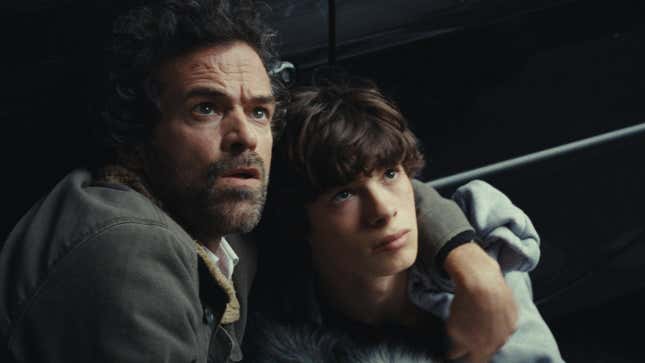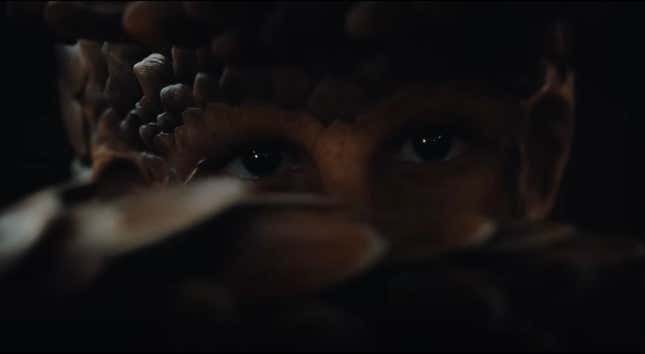For many of us, it’s impossible to hear the word “mutant” and not immediately think of the X-Men. Marvel’s 60-plus-year-old team of mutants, the subject of comics, movies, shows, toys, and more, have so dominated pop culture, especially over the past few decades, it’s a valid train of thought. So, when I tell you there’s a great new mutant movie coming out, you might first think I’m talking about Deadpool vs. Wolverine. I’m not.
I’m talking about The Animal Kingdom, a powerful, poetic, and rousing film from director Thomas Cailley. Set in a world where certain humans have mysteriously begun changing into hybrids of themselves and animals, the film follows a father and son dealing with a mutant mother and, eventually, much more. It opens in select theaters and on demand Friday and comes with our highest recommendation, so io9 sat down with Cailley to talk about it.
Speaking on video chat with the aid of a translator, the co-writer and director explained why he believes the subject of mutants is much more complex than just the X-Men. We also talked about how he’s using that metaphor as a mirror on our humanity, as well as the stunning creature design, filming on location, and how that cohesion added a level of realism films starring Cyclops, Wolverine, and Storm could never achieve.
Enjoy the interview with Cailley below, and definitely check out The Animal Kingdom in theaters and on demand March 15.
Germain Lussier, io9: So despite my excellent review, my guess is most of my readers won’t know much about The Animal Kingdom. Please tell me how the idea came to be.
Thomas Cailley: I started writing the film in 2019 with my co-screenwriter Pauline Munier. And what I liked was this idea of mutation, which on the one hand is looking at what it means to grow up, to become an adult, but also allowed for an exploration of the black box of the parent-child relationship and the theme of transmission. It also allows us to see what happens in a society where everything is turned upside down, where suddenly things are changing very fast and certain instincts are being awakened. Instincts of unconditional love, but also rejection and violence. And this was a way of raising these important questions of how we all live together and get along.
io9: I have to admit, when I first read about the film at Fantastic Fest, my first thought when I saw “mutant” was “X-Men.” And I’m sure lots of people have that same connection. Obviously, this is nothing like that, but how much, if at all, did you look at or think about either the X-Men or any other kind of mutants in pop culture before attacking them yourself?

Cailley: I think the metaphor of hybridization between humans and animals goes much further back than comic books and the X-Men and the Marvel Universe. There are animal-human hybrids on the walls of prehistoric caves. So it’s a very, very old story that goes back to the time when we still thought of ourselves as belonging to the vast world that we now refer to as nature. Once cinema took hold of this theme of hybridization, it has basically gone in two directions. The one direction is that of monstrosity. Humans becoming animals and therefore turning into monsters. The other direction is humans taking on animal abilities or powers, and that turns them into superheroes such as the X-Men. Our ambition here was to have characters who would be neither monsters nor superheroes. And that’s why as soon as a character takes on an animal characteristic or trait, he or she loses a human characteristic or trait. And that keeps our characters somehow incomplete in their nature, which I think is the basis of our humanity.
io9: Wow, I love that. I also love that while this story could have been told on a global scale, sort of like Independence Day, you decided to really focus it and tell that global story on a personal level with the relationship between father and son. How was the decision made to tell this story in that way?

Cailley: What structures the screenplay and the story of the film is indeed this relationship between the father and son. And that was what interested me on the most primary level. It’s how a parent looks at a child and how that changes. That, I think, is the most universal aspect of this society. The way that the mutation affects Émile is, of course, a metaphor for the passage to adulthood, to maturity. And what Francois, the father, has to learn in the film is to allow his son, his child, to become what he must become, and therefore to learn to live without him. That’s really what’s at the center of the film. Then there are other parts of the film that move towards the thriller, or even body horror, and we also tried to really look at what the film’s story meant in terms of politics. How these mutants are accepted in society. But you’re right to say that at the center of the film is the love between a father and son, and how that love changes us.
io9: Of the two characters, the one I most related to was Émile because of how he personally deals with his gradual change from human to animal. It happens in such a smart, logical way, so I was wondering how you tracked how the character arc would play in the film.

Cailley: For me, it all starts with and comes from his mother. When the film begins, these mutations have been happening for two years already and they’ve transformed the world. And Émile’s mom is one of the people who is directly affected by this disease. And at the beginning of the film, Émile rejects his mother. And I think that’s because he believes he has the right to a normal adolescence, and that’s what’s going to put the father and son characters in opposition to each other, which is that the dad absolutely wants to keep his clan together. He wants the mother to stay in this family. And so we’re starting from Émile rejecting what is abnormal. He rejects the abnormality of his mother.
But like in a fairy tale, the worst nightmare always comes true. And so, at the moment where Émile has nearly gone so far as to want his mother to disappear, that’s when he starts to mutate. And in his mutation, he’s going to discover positive emotions. His relationship with the young woman in the film is allowed by what comes from mutation. His relationship with the Bird Man is also thanks to his mutation. His mutation allows him to really become brave. And that allows him to grow faster. And from there, it’s like the relationship with the father is reversed, because at the beginning, the father is full of certainty and Émile is not. And what eventually happens is that Émile knows where he has to go. And the father is uncertain about everything. He has no certainties. And what I find very beautiful at that point is that the son’s courage inspires his father.
io9: Now, I want to get into the creature design a little bit because not only is the design beautiful, but the execution is magnificent. Tell me a little bit about the process. Was it a traditional evolution with concept art and the like? How did you develop all the different looks for all the mutants in the film?

Cailley: Well, we started working, based on the screenplay, with comic book creators and character designers. We did that for several months, and then we started to use what had been attempted in that work in the casting. We tried to find actors who had peculiar bodies, unusual bodies, or had specific, unusual ways of using their bodies. And then very quickly, the big debate, the big question was how to pull off our technological mix. I didn’t want to have 100% digital effects or CGI. I wanted the film’s effects to be concrete, organic, and so we decided to do the maximum effects on set. And we realized that to do that, we would need a mix of technology. So we always rely on the acting. There’s always an actor in front of the camera. There’s a lot of prosthetics, there’s a lot of practical effects on set, and then there’s also some digital effects. We also decided to shoot exclusively on location. No studios, no green screen, so that the film would be as natural and as realistic as possible.
io9: Which leads me, unfortunately, to my last question. How did shooting on location change your approach to effects and costumes? Surely it meant you couldn’t hide as much.
Cailley: Shooting in real locations you have real vegetation and natural light, and that gives a very specific color and contrast to things. So when you’re shooting your real effects in real locations, it helps you to find the film’s coherence, meaning that you’re thinking about the effects and everything else in the same way. They’re part of the same image, as opposed to different phases of the production that are perhaps going to be months apart when you’re doing effects in post-production. And so what was interesting for me in filming in real locations is that you’re filming something that’s alive. The forest is a living entity. The wind, the light, leaves falling, the ground. All of this raises the film’s standard of realism. And in that case, CGI’s job is to bring the highest level of credibility to the image. Whereas when you’re filming with green screen, CGI sets the standard of credibility. If I’m filming in real locations, it’s me and my crew who are setting that standard. And that’s what I prefer because it allows me to control what I’m doing.
Trust us, Cailley knows what he’s doing. The Animal Kingdom is in theaters and on demand Friday, March 15.
Want more io9 news? Check out when to expect the latest Marvel, Star Wars, and Star Trek releases, what’s next for the DC Universe on film and TV, and everything you need to know about the future of Doctor Who.
Trending Products

Cooler Master MasterBox Q300L Micro-ATX Tower with Magnetic Design Dust Filter, Transparent Acrylic Side Panel…

ASUS TUF Gaming GT301 ZAKU II Edition ATX mid-Tower Compact case with Tempered Glass Side Panel, Honeycomb Front Panel…

ASUS TUF Gaming GT501 Mid-Tower Computer Case for up to EATX Motherboards with USB 3.0 Front Panel Cases GT501/GRY/WITH…

be quiet! Pure Base 500DX Black, Mid Tower ATX case, ARGB, 3 pre-installed Pure Wings 2, BGW37, tempered glass window

ASUS ROG Strix Helios GX601 White Edition RGB Mid-Tower Computer Case for ATX/EATX Motherboards with tempered glass…










